 |
|
 09-21-2016, 08:22 AM
09-21-2016, 08:22 AM
|
#51
|
|
Senior Member
Join Date: Jul 2013
Location: So Cal
Posts: 4,072
|
If you want to update things then yes replace the isolator with a separator, consider an inverter/charger (some units are very affordable these days), and consider an AGM house battery.....and solar while you are at it.
Since you are local, many of use have bought cosmetic blem Lucent-Alcatel AGM batteries from 619battery.com in San Diego. Depending on how many he needs to deliver, Jeff will sometimes bring them to you in OC. They are 175ah and cost $125...and they are AGM sealed.
The one caveat with these batteries is that they are not a std automotive group size. They are slightly smaller than a 4D.
__________________
2008 E350 RB passenger 4WD SMB penthouse
2013 KTM 350 EXC
2008 KTM 250 XCF-W
2003 Honda Element
|

|

|
 09-25-2016, 01:25 PM
09-25-2016, 01:25 PM
|
#52
|
|
Senior Member
Join Date: May 2014
Location: OrangeCounty, CA
Posts: 1,275
|
OK, time for some updates to this thread.
1st off --- had a great chat on the phone with boywonder. (thanks btw!!!) In addition to discussing the still-in-play battery mystery, got some really solid advice and leads on battery maintenance, chargers, power supplies.
The problem at hand, reiterated:
My fully-charged, brand-new house battery (Group 27, Lead-acid deep cycle rated at around 100 amp-hours) has been losing its charge FAST whenever a low-amperage item like a single LED light or two was turned on.
So, at a number of the forum members advice, I started with thorough battery-testing first.
Step 1: Attempt to charge the house battery TRULY fully, with a 110V AC bench charger.

Overnight-charged it on the 2-amp trickle-charge setting, it was charging for a good 10 hours.
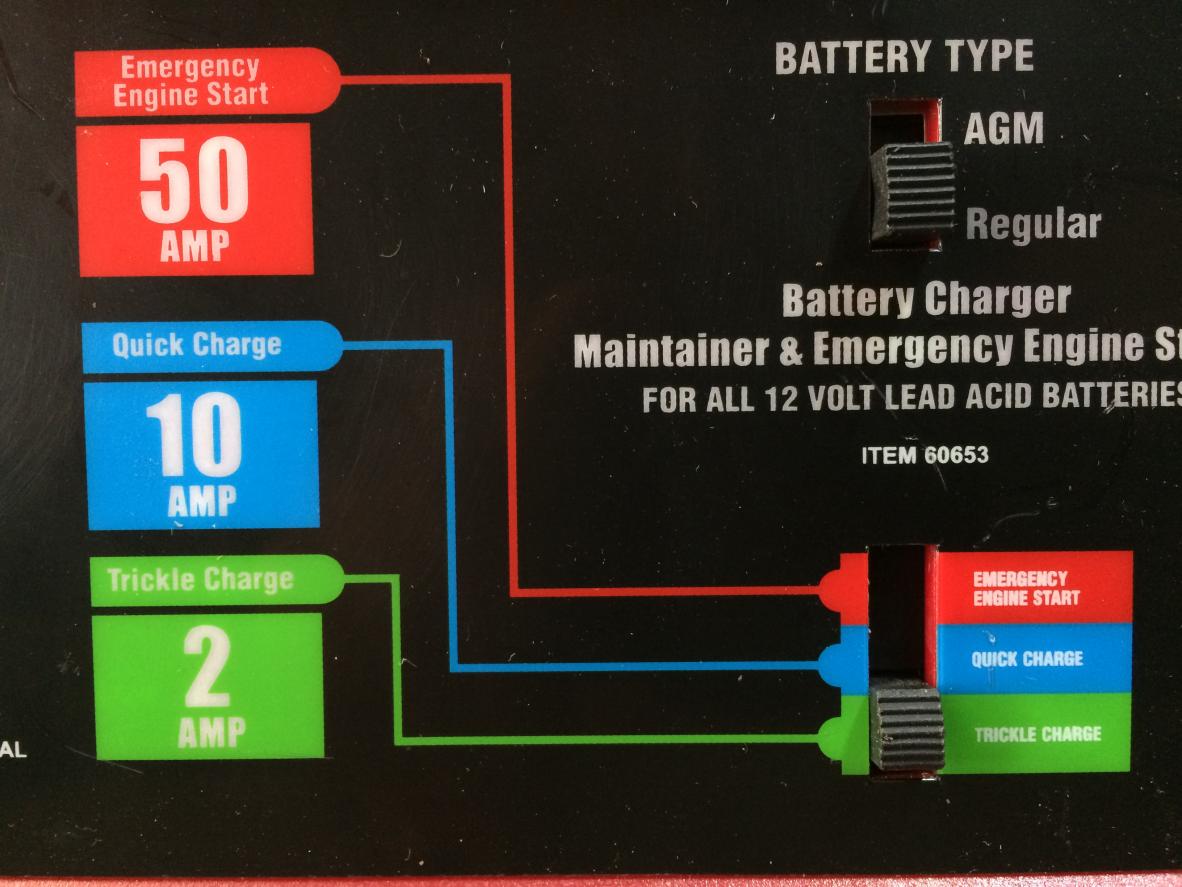 
This is (from what I understand) a "semi-smart" charger, in that it will drop voltage once it detects a state of full charge (however it does that.) So while it was initially charging, the voltage measured at the terminals was in the 14's.

Once the charger detected "full charge," its LED switched from red to green...
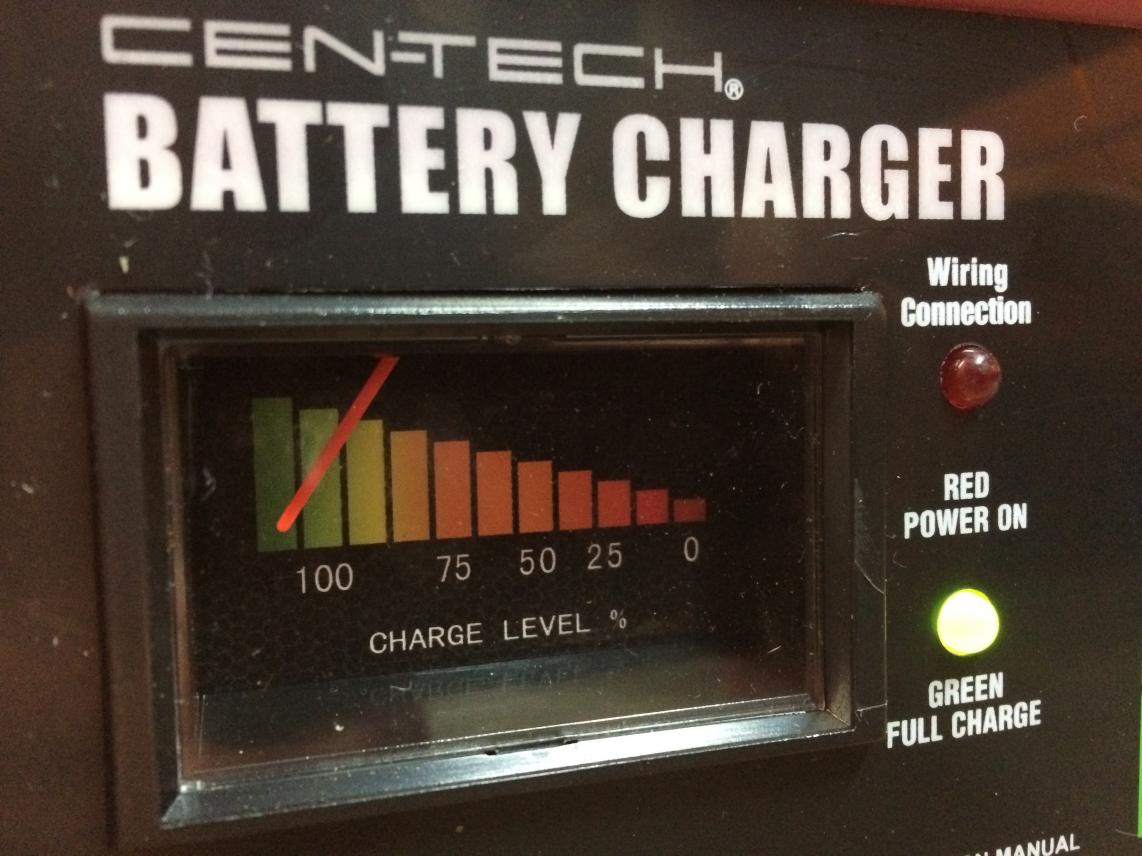
... and (I believe) it then stopped charging the battery entirely.
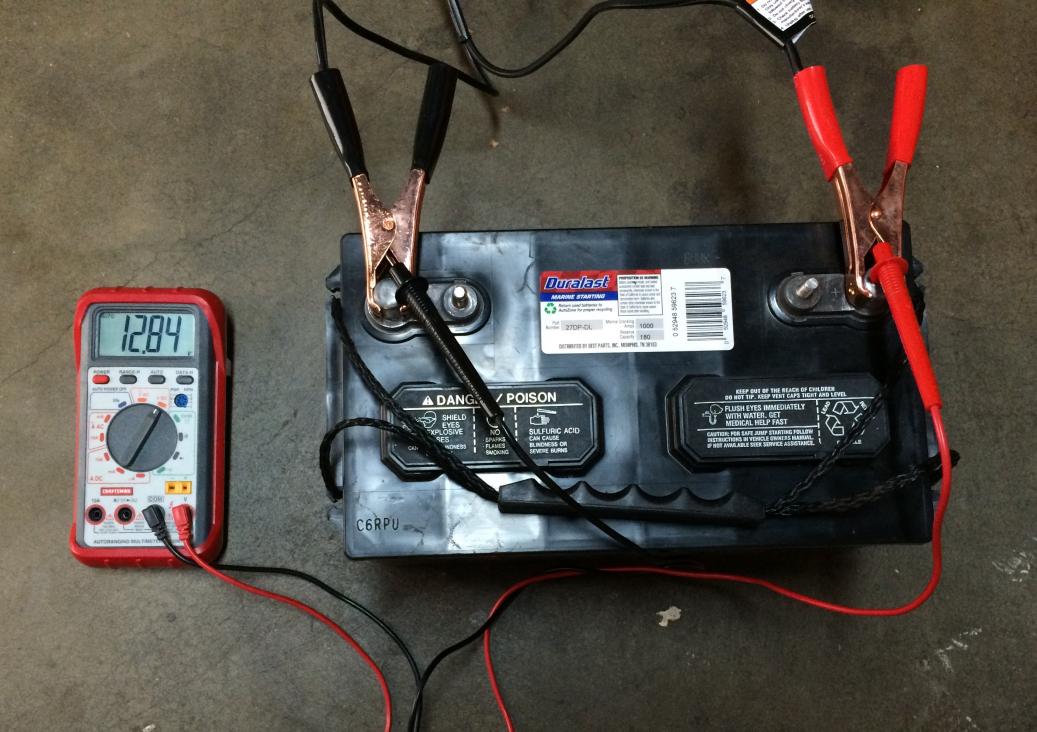
SO --- the measured voltage at the battery terminals (with battery charger disconnected) this morning was 12.87 volts.
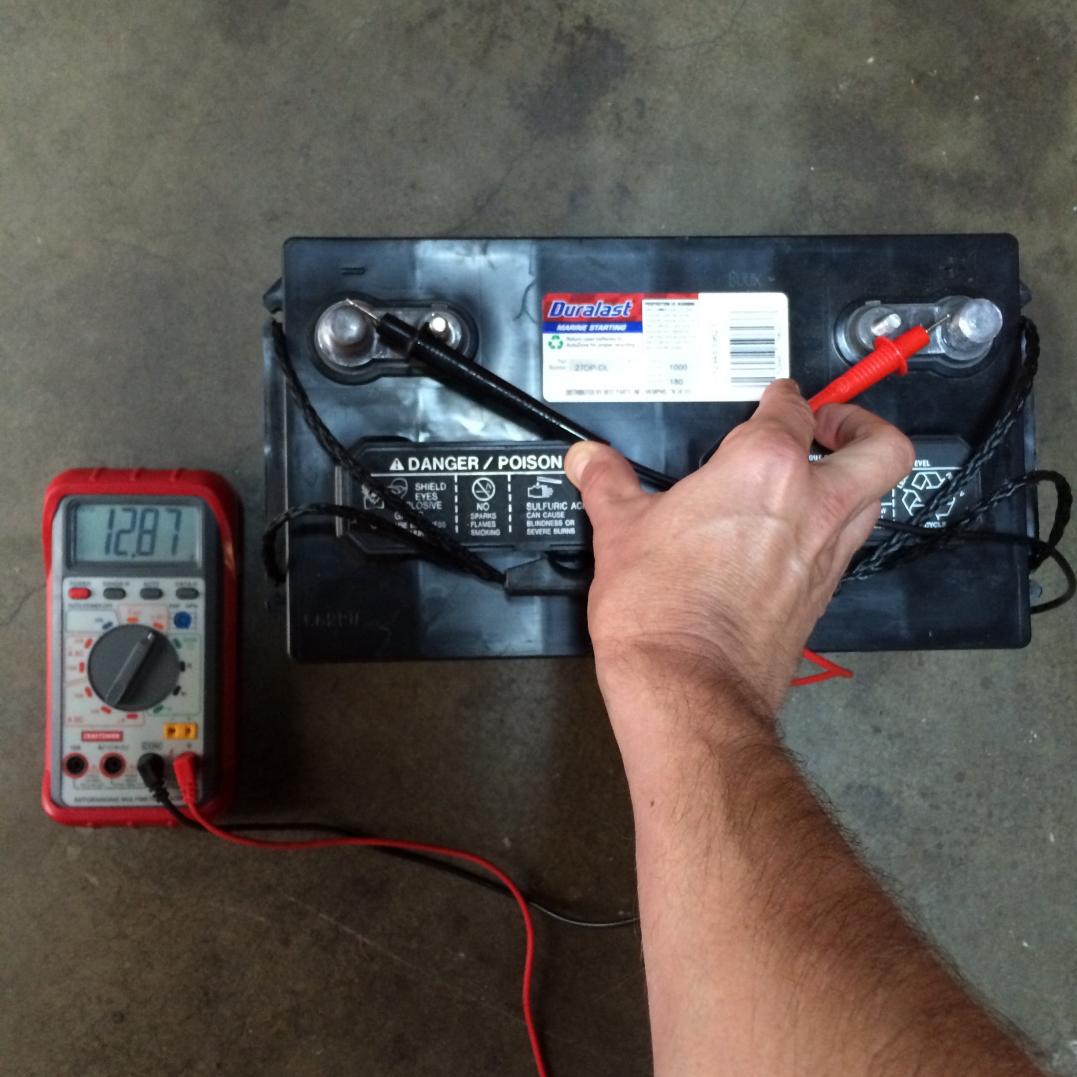 ....continued:
NEXT:
....continued:
NEXT: More battery testing --- and then back to the van.....
__________________
Mike T
___________________
'95 Ford E250 RB30 PH
|

|

|
 09-25-2016, 01:37 PM
09-25-2016, 01:37 PM
|
#53
|
|
Senior Member
Join Date: May 2014
Location: OrangeCounty, CA
Posts: 1,275
|
(Continued)
Step 2: Check the battery's physical basics.
(I actually did this a couple nights ago, when the battery was at a solid (at least indicated) state of charge.)
First thing was to gather the short list of necessary elements required to "crack open the ports" and check the fluid levels and specific gravity of the battery.
Yep, that's distilled water, grabbed it in the bottled water aisle at the grocery store for 99 cents.
 The hydrometer I got off of Amazon for about 10 bucks,
The hydrometer I got off of Amazon for about 10 bucks, it was well-reviewed (and as easy to use as they said it was.)

I didn't take any pictures of the "ports open, check the water levels and specific gravity' part of this process (mostly due to wearing rubber gloves and dealing with battery acid). But it's not much to see, and there's tons of youtube videos that depict the process (one is linked to earlier in this thread.) There's six cells (six holes to look into and check water levels) when you pop off the caps (safety first!!! Safety goggles and gloves in effect the whole time.)
The results:
Levels were completely full in all six cells, and specific gravity measurements were all a healthy indicated number (and all the specific gravity numbers matched closely.)
So the battery at this point (with all the bench testing so far) really seems to be OK.
And I should mention again --- it's only a month or two old.
NEXT: On to the VAN! (and then some follow-up load testing, again.)
***continued....***
__________________
Mike T
___________________
'95 Ford E250 RB30 PH
|

|

|
 09-25-2016, 01:59 PM
09-25-2016, 01:59 PM
|
#54
|
|
Senior Member
Join Date: May 2014
Location: OrangeCounty, CA
Posts: 1,275
|
NEXT: BENCH TESTING THE AMP DRAW OF LED FIXTURES
Since the problem I'm trying to sleuth out revolves around the house battery losing voltage fast when it's running super-low-current-draw items, it was advisable to check what the true measured current draw of those items actually is.
So --- a couple nights back I did just that. I grabbed three separate LED light types in the van (one each of the following, which I will refer to as " large LED tube light," " corn cob LED reading light," and " small flat LED reading light," and used my handy Craftsman multimeter (in series with the lights) to see how much juice they really pulled.
 The measured numbers were indeed low.
The measured numbers were indeed low.
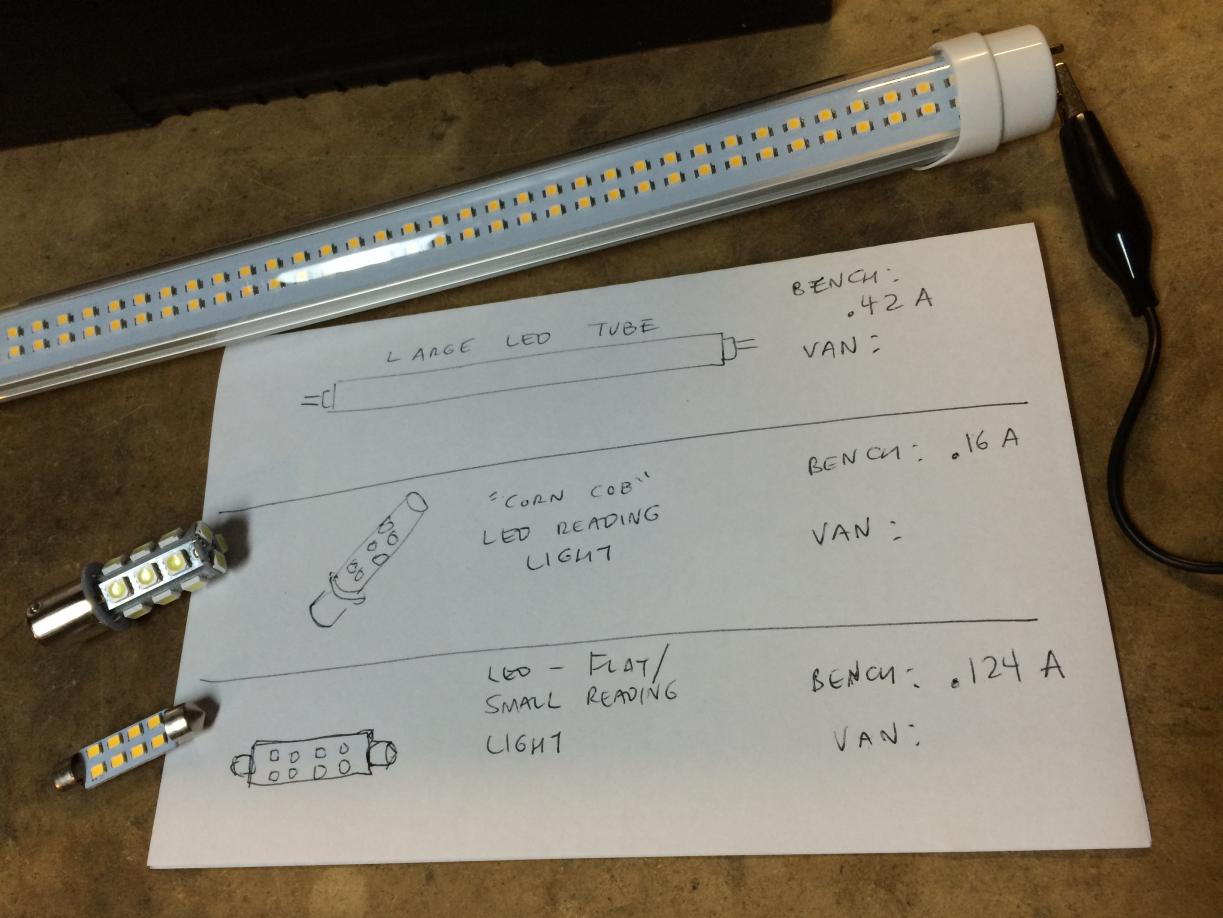
Ok so now, there was only one thing left to do....yep,
Ok at last....BACK TO THE VAN!
(....continued....)
__________________
Mike T
___________________
'95 Ford E250 RB30 PH
|

|

|
 09-25-2016, 02:12 PM
09-25-2016, 02:12 PM
|
#55
|
|
Senior Member
Join Date: May 2014
Location: OrangeCounty, CA
Posts: 1,275
|
NEXT: GET BACK IN THAT VAN, GOOD BUDDY
Back in the van....! I love it in here.
Seriously its my favorite place. All that aqua/teal carpeting and woodgrain.....no matter how stressed out I am trying to fix something, it always seems to calm me down. 
Anyway --- first thing I noticed, right away, (battery put back into van and hooked up) --- was that there was already a measured current draw at the terminals, ***without anything even turned on***.
 (More on this in a second) -- but first, at the time.
(More on this in a second) -- but first, at the time....despite the fact that I couldn't make sense of what that current draw could be, I went ahead and measured, once again, the current draw for each of the very same LED lights I had bench-tested, only with them now re-installed in their onboard light fixtures.
Numbers changed very little, as shown:
 I still wasn't sure where the phantom .066amp current was going
I still wasn't sure where the phantom .066amp current was going....but then I realized that recently I had hard-wired an "always on" propane detector into the van's electrical system.
 Removing its fuse from the block immediately eliminated that .066amp current draw.
Discussing this with boywonder,
Removing its fuse from the block immediately eliminated that .066amp current draw.
Discussing this with boywonder, he was of the opinion that possibly that propane detector, over the course of weeks of being hooked up 24-7, has been slowly drawing down the batteries and preventing a full charge from ever truly happening. (My van will often sit for a couple weeks or more between trips).
NEXT:
The last bit of today's in-the-van testing, a brief exploration of crappy voltmeters, and a final battery load test.
*** continued once more ***
__________________
Mike T
___________________
'95 Ford E250 RB30 PH
|

|

|
 09-25-2016, 02:32 PM
09-25-2016, 02:32 PM
|
#56
|
|
Senior Member
Join Date: May 2014
Location: OrangeCounty, CA
Posts: 1,275
|
VOLTAGE DROP: IN-THE-VAN TESTING:
Today I wanted to re-test for the original phenomena, the house battery voltage dropping fast (from an indicated full charge) when I popped on a couple LED lights.
So I went out to the van armed with an array of voltmeters. Of course I had the trusty Craftsman unit, but also wanted to check, once again, the accuracy of the plug-in-the-12v-wall-socket craptastic 10-dollar units that so many of us rely upon to gauge our battery's charge status.
Picked up one of these decently-reviewed Innova units for ten bucks off of Amazon, I thought it would be better to try one out that reads voltage to the hundredths place.
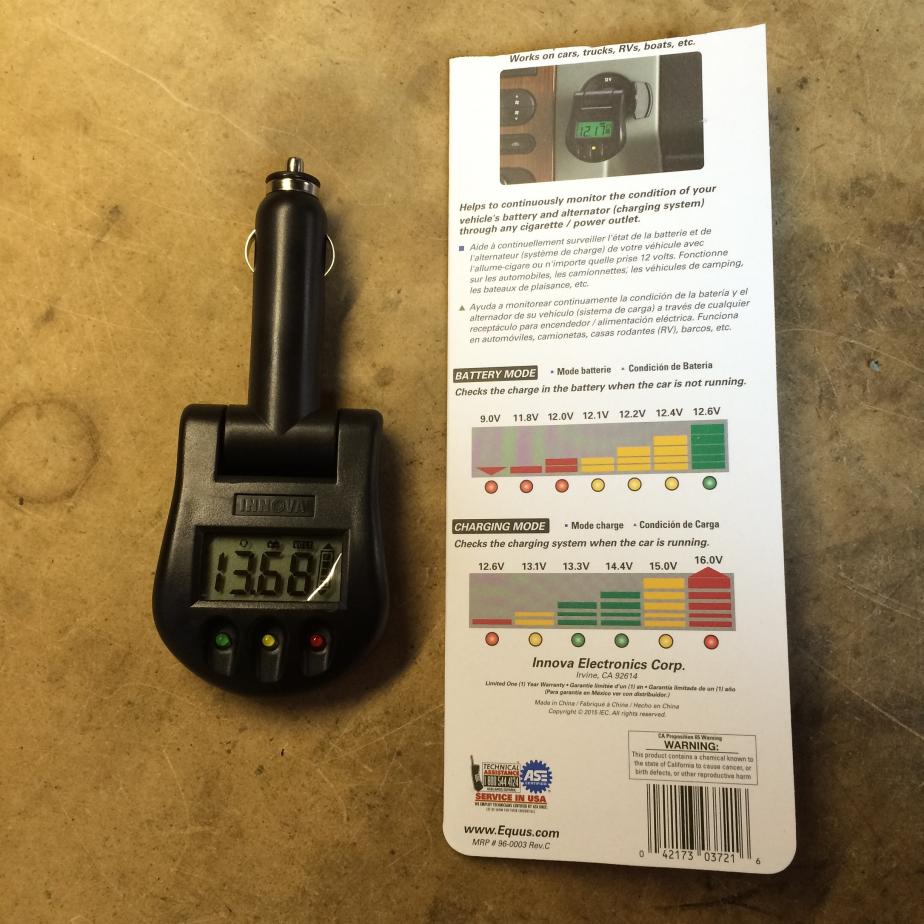
And for comparison, the original one I've been using next to it:

And this was immediately interesting. Side-by-side comparison (at the terminals!) of what these two voltage meters read. One big winner, one big loser.
So let's start with the old one:
Right on the money! 12.8 shown vs. 12.84 on the multimeter.
 And next, the much-anticipated-to-be-fantastic new one:
And next, the much-anticipated-to-be-fantastic new one:
FAIL! Even with all that hundredths-place-readout awesomeness....it's not even CLOSE to being accurate.
 Moral of the story:
Moral of the story:
Don't rely on any of these craptastic plug-in wall socket meters too much.
And for testing purposes.....use a real electrician's multimeter......
LIGHT LOAD TESTING
So at last --- lets do what we set out to do today ---- use that multimeter and see what the voltage drop is on this properly-charged battery, once we start turning on some lights.
STEP 1:
With four LED lights turned on (the large tube light, and 3 separate reading lights, the voltage immediately dropped from 12.84 to 12.66 volts.
 STEP 2:
Shutting off the lights,
STEP 2:
Shutting off the lights, within a minute or so the battery rebounded to 12.71 volts.
 Satisfied with the day's in-the-van testing, I
Satisfied with the day's in-the-van testing, I then pulled the battery and went back to the garage bench with it for a last round of quick load testing / voltage measurements.
***continued once more for today****
__________________
Mike T
___________________
'95 Ford E250 RB30 PH
|

|

|
 09-25-2016, 02:49 PM
09-25-2016, 02:49 PM
|
#57
|
|
Senior Member
Join Date: May 2014
Location: OrangeCounty, CA
Posts: 1,275
|
THE WRAPUP FOR THE DAY -- FINAL QUICK LOAD TESTING
In the minutes that followed (perhaps five or ten more minutes?), the battery's voltage rebounded further. By the time I got it out of the van, returned it to the garage, and pulled out the load tester again, the battery was measuring itself to be back up to a pretty healthy 12.81 volts at its terminals again.

Running a quick load test, it indicated a pretty healthy reading while the test was being run:

And the battery quickly rebounded immediately afterward to read 12.73 volts.

CONCLUSION...FOR NOW?
After all of this, I'm very interested to hear what the electrical experts here think is most likely the reality of the situation (what's going on with the mystery sudden voltage drop when house battery is used.)
I'm tending to think that boywonder's assertion holds a lot of weight ---- that the house battery has been both 1) getting drawn down slowly by the propane detector while the van sits between trips and 2) never truly charging up fully afterward, since its been relying on *only* the onboard van alternator to deliver it a charge (and this not happening often enough.)
Based on all the great advice from you guys, and also upon the testing I've done so far......my current plans (and actions) are:
1) leaving propane detector disconnected until it's time to go on a trip
2) looking into getting a Blue Sea Separator to replace the old, original isolator
3) looking into replacing the original "Todd Engineering" onboard battery-charger/power supply with a more modern 3-stage smart charger system capable of desulfating...and then regularly leaving the van plugged in to a land line 110AC when the van is parked at home.
Possibly additionally:
4) looking into a mechanical switch for fully disconnecting the house battery from the entire RV electrical system when the van is parked between trips
Again ---
Big thanks for everything you've offered and helped me to understand so far you guys!!! Hope this helps others who bounce through this thread to learn a thing or two as well.

__________________
Mike T
___________________
'95 Ford E250 RB30 PH
|

|

|
 09-25-2016, 07:08 PM
09-25-2016, 07:08 PM
|
#58
|
|
Senior Member
Join Date: Jan 2013
Location: Lake Tahoe
Posts: 216
|
3) looking into replacing the original "Todd Engineering" onboard battery-charger/power supply with a more modern 3-stage smart charger system capable of desulfating...and then regularly leaving the van plugged in to a land line 110AC when the van is parked at home.
Possibly additionally:
4) looking into a mechanical switch for fully disconnecting the house battery from the entire RV electrical system when the van is parked between trips
I am still working the Todd Engineering thing. I added a switch so I can manually set it to the higher 14 volt charge or 13 volt float charge when sitting for a long time. If the jumper is set on yours it is probably on 13 volt float and is why you never get a full charge
I have added the disconnect switch. I prefer this to leaving it on float. (running two 27s in parallel.) So mostly i leave it on 14 volt and then just fully disconnect after charging so I don't worry about things draining it.
What I have wondered about is: what are long trips charging at 14 volts from the alternator when it is already charged doing to the battery? Makes me think I should disconnect the house battery on long drives. Are long drives overcharging the batteries?
__________________
1996 Ford EB 2 wheel drive 460
|

|

|
 09-26-2016, 06:17 AM
09-26-2016, 06:17 AM
|
#59
|
|
Senior Member
Join Date: May 2007
Location: Beaverton, OR
Posts: 2,506
|
I would prioritize as this:
1) Replacing the Todd Engineering with a newer 3 stage charger.
2} Put a disconnect on the whole battery system. When you get home from a trip, put it on the charger and make sure that you get a full charger on it and then use the disconnect switch.
3) Invest in a good battery monitor, as it will help in your overall maintenance of your battery system, debugging problems and such.
4) Replacing the isolator.
I think you did a great job with sorting all this out and agree with your conclusions.
-greg
__________________
-greg
__________________________________________________ ______________
"Goldilocks" 2020 Ford Transit High Roof Extended 3.5 EcoBoost AWD Homebuilt
|

|

|
 09-26-2016, 06:49 AM
09-26-2016, 06:49 AM
|
#60
|
|
Senior Member
Join Date: Jul 2011
Location: TN
Posts: 10,254
|
I totally agree with Scalf. He knows his stuff and I'm glad he chimed in.
A couple of things I did to my previous van. First, I put a toggle switch on the power wire of my propane detector. I hid it in behind the detector which was underneath the gaucho. I did this for a couple reasons. One, it won't get accidentally turned off. Second, I can not only cut out the battery draw but also can silence it if it's screaming and I know why. Just remember to turn it on when using the van! Turning your propane off at the tank, unless using it, is also always a good idea.
Second, instead of relying on one of these plug in craptastic digital meters, which I must confess I have done too, you can easily and simply add a more reliable built in one. I just put this combo in my new van and in my last I actually used two, one for the front batteries and one for the rear.
https://www.amazon.com/gp/product/B0...?ie=UTF8&psc=1
You can, of course, just get a simple digital meter only and mount it somewhere like I did here on the left of my dash. Sorry for the fuzzy pic.
 12V 24V Car Motorcycle LED DC Digital Display Voltmeter Waterproof Meter QV | eBay
DC 3 50 30V 4 Digital LED Volt Voltage Meter Voltmeter 5V 12V 24V Car Battery R | eBay
12V 24V Car Motorcycle LED DC Digital Display Voltmeter Waterproof Meter QV | eBay
DC 3 50 30V 4 Digital LED Volt Voltage Meter Voltmeter 5V 12V 24V Car Battery R | eBay
Last, if you get a good inverter, charger like a Tripplite it will have a great 3 stage charger built in. I've been thinking of buying mine back from Larrie but I've got too much going on right now, so here it is if he still has it:
http://www.sportsmobileforum.com/for...0-a-17686.html
I shopped for awhile before I went with that 1250 and found it to be the perfect balance in size and capability for our rig and probably most SMBs. It'll run a small microwave and most other appliances you might plug in to a camper van. Beware of hair dryers! If you're running a good size appliance off an inverter I recommend idling the engine just while running it. It helps out a lot with maintaining your charge.
Great write up/update! Thanks for sharing

|

|

|
 |
|
 Posting Rules
Posting Rules
|
You may not post new threads
You may not post replies
You may not post attachments
You may not edit your posts
HTML code is Off
|
|
|
|
 » Recent Threads
» Recent Threads |
|
|
|
|
|
|
|
|
|
|
|
|
|
|
|
|
|
|
|
|
|
|
|
|
|
|
|
|
|
|
|
|
|